Learn the Hungarian Alphabet in 4 Easy Steps (with Pronunciation)
Let us get this straight: The Hungarian alphabet is EASY!
It’s way easier than the English one and also a lot more useful. You read this right. Yes, it has 40 letters (to be perfectly correct it’s 44, but we don’t really ever use “Q”, “W”, “X” and “Y”. Only in foreign words. You’ll know how to spell those.) and yes, Hungarian words look weird at first. But while the English alphabet prides itself on having only 26 letters, learning these won’t actually get you anywhere.
Why? Because English is not a phonetic language. English words are not pronounced according to the alphabet. Take the word “juice” as an example. Having learned the English alphabet and having no other knowledge of the language, you would probably pronounce “juice” as something, like “j-you-i-cee”, since you’ve learned that a u is a “you”, an i is an “I” and an e is an “ee”. 26 letters just aren’t enough to express the complex pronunciation system of the English language and even after years of studying and speaking the language fluently you probably find yourself guessing how to say words like “gouge” or “gauge” correctly and asking why “heart”, “beard” and “heard” are each pronounced differently.
As you might’ve guessed by now, the case is different with Hungarian. Its 40 letters are not a curse but a blessing and having learned these letters will enable you to pronounce each and every single Hungarian word. Correctly. Without second-guessing. These 40 letters are just the right amount of letters you need to actually represent a pronunciation system. You will need about an hour to remember all of them, which is not that much for what you get in return.
So bear with us and let’s master this weird-looking maze of letters and apostrophes together – here are our 4 easy steps to learning the Hungarian alphabet.
1. Start with the weirdest Stuff of the Hungarian Alphabet
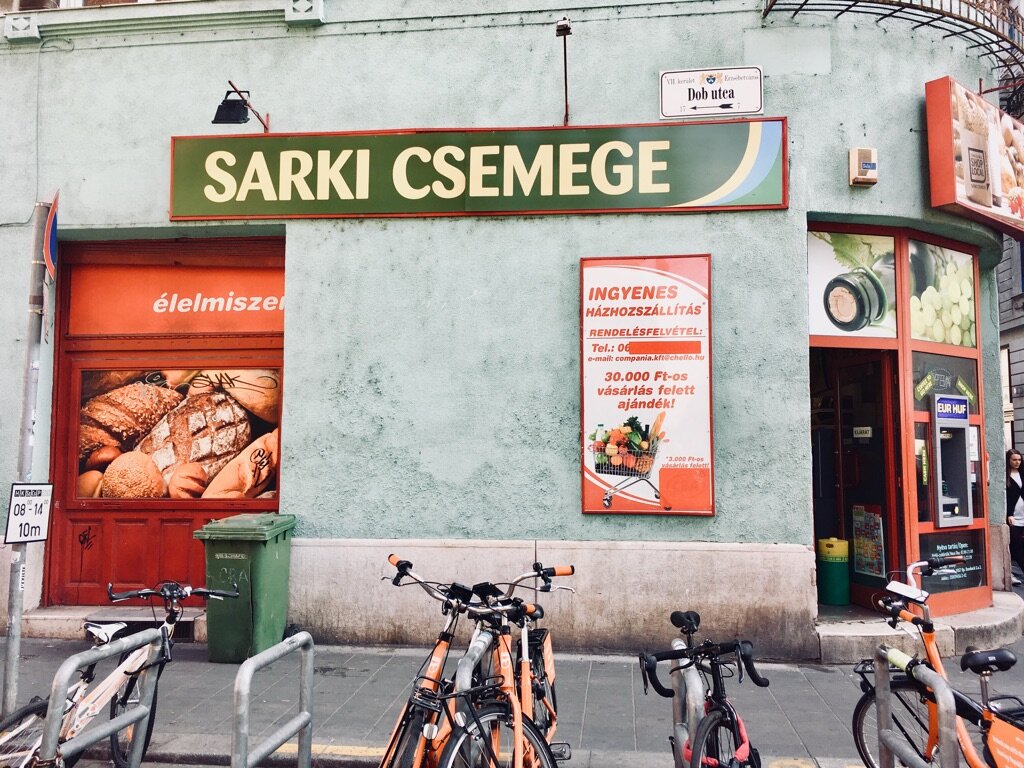
You have all our sympathy if a word like “karácsony” freaks you out (don’t worry, it only means Christmas though…). A c behind an s is weird and so is the y behind the n. Well, these are actually the so-called ”digraphs”, but since I’m not a linguist, I just call them double-letters. The idea behind them is to express one single sound with two or three letters from the latin alphabet. This means, that c+s are actually one letter with only one possible sound. So are n+y. There are eight such double-letters and one triple-letter in the Hungarian alphabet:
That’s it. Learn these letter-combos and remember that they always, always represent the same single sound. Congratulations. You’ve conquered the hardest part of the Hungarian alphabet. “Karácsony” shouldn’t really freak you out anymore. Well, except for maybe the “á”, which takes us to the second step of…
2. Get acquainted with the Apostrophes
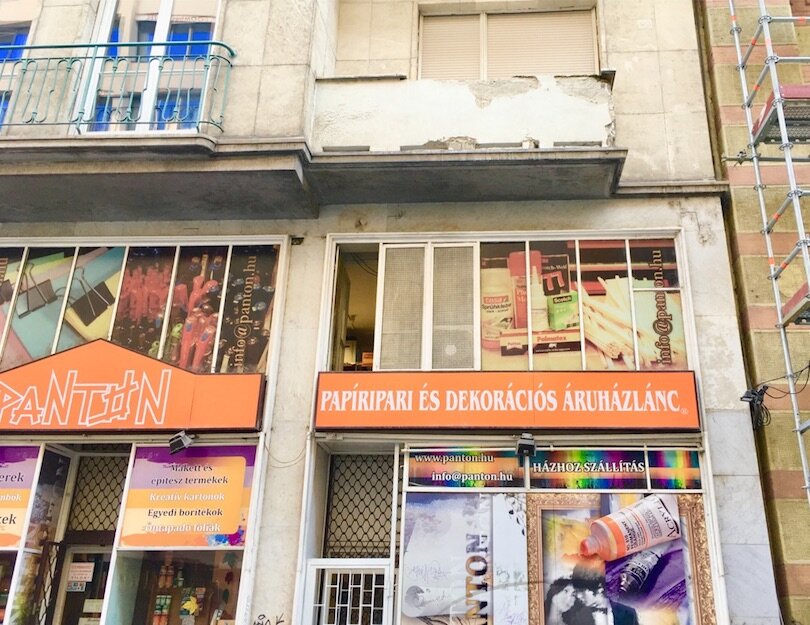
These weirdo little strokes are admittedly unfamiliar for the English speaker, but they are totally harmless. Their one single function is to lengthen the vocals in a word. As an example, if you see an “í”, it just means that you have to pronounce it longer, than the “i”. The only exceptions are “á” and “é” – they are spelled a bit differently, than their apostrophless cousins:
For all the rest (í, ó, ő, ű) – just hold the vocal for a bit longer and you’re good (hear pronunciation below).
By now, you have conquered everything that freaks people out about the Hungarian alphabet. All that’s left is walk in the park.
33 HUNGARIAN HISTORIES – Get our EBOOK
Understand the Hungarian Mentality through 33 Captivating Stories of Inherently Magyar Personalities
Whether you’re in search of your Hungarian roots, are living in or travelling to Hungary or you’re just curious about the history of this tiny but ever-proud nation – this book is for you.
3. Learn the Rest of the Hungarian Alphabet
Now let’s go through the rest one by one and you will see that most of what’s left is similar to what you know from English. I’ve marked those letters which are fundamentally different from what you’d expect with a![]() .
.
![]()
![]()
![]()
![]()
![]()
![]()
![]()
Final Note:
Just like in English, we simply double long consonants in writing. If the consonant you want to double is a digraph or the trigraph, you just double the first letter of it.Let’s see a few examples for that:
Single Consonants:
Double Consonants:
And that’s it. Now you can read “karácsony”. And “csúnya”. And even “zsibbasztó”. Or ”dzsúsz” (yes – we made this one phonetic, too.) And everything else.
4. Practice the Hungarian Alphabet!
Now let’s see how far we’ve got you. Try to spell the following 15 words out loud and only listen to the pronunciation for reviewing purposes.
Bonus:
Congratulations! You have now mastered the Hungarian alphabet. But don’t forget though, that the real practice is to just walk through the streets of Budapest and decipher all signs you encounter. Try to read the street names, the names of the cafés and restaurants and see what’s written on the stores.
Bonus: Our Cheat Sheet for the Hungarian Alphabet
Should you get stuck somewhere, fear not: Here is our cheat sheet including all those letters and their pronunciation that you could possibly forget. We’ve created it for you with love and lots of warm colours. You can save it to your phone or print it out and take it anywhere you want. In Budapest and beyond.
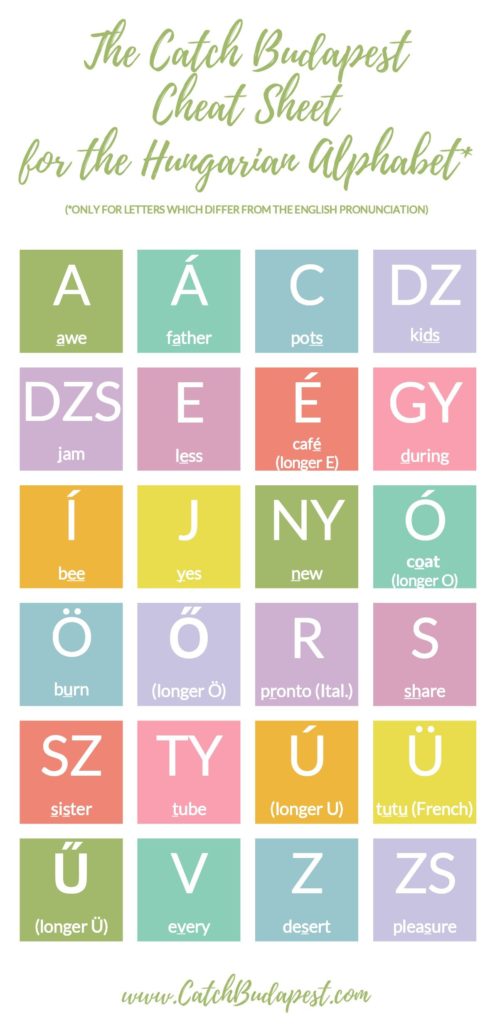
And one last tip at the end:
If you are desperately looking for the Hungarian characters on your non-Hungarian keyboard, you can use this page instead, to type the missing Hungarian characters.
Have fun and don’t forget to tell us about your favourite new word that you can now spell in the comments!
More posts about Learning Hungarian:

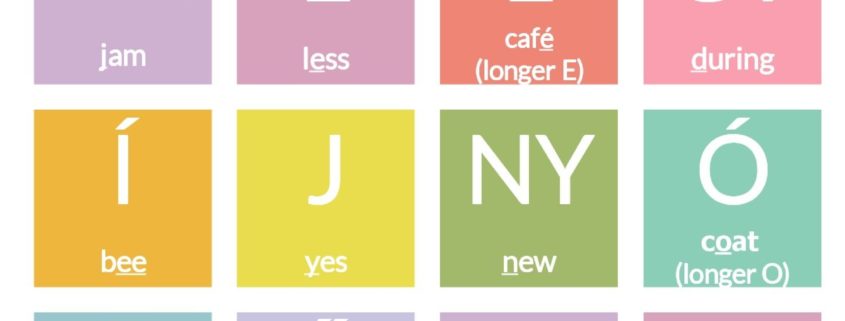


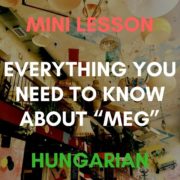
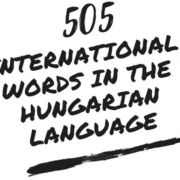

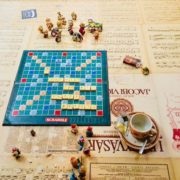


I totally love this article!! 🙂 I used to try to learn Hungarian but it’s not that easy 😀 I love the sound of the language, anyways 🙂
Thank you so much Katarzyna!! Hungarian is definitely not “easy” in the classical sense, but it’s no mission impossible either. That’s the spirit we want to spread 😉
Best,
Julia
Just as a brief additional note: the English Word “awe” doesn’t even have the proper sound of “a”, it rather resembles to the one represented by our letter “ó”. Nor does “coat” have the exact sound of “ó” as it’s pronounced with a so-called diphthong comprised of the Hungarian “öu”. If you were referring to the American pronunciation instead of the preferred British way, then telling the learners about the case where they should say the “gy” like in “during”, it won’t help because American don’t tend to put the extra “y” sound in there: so again they may pronounce it “doo-ring” and not “d-yoo-ring” or anything like that. There isn’t really an appropriate equivalent in English to what we use as digraphs (here I mainly mean the “gy” & “ny” – due to same reasoning). Moreover, Brits don’t usually pronounce the “r” sound either, so “early” makes the magyar “ő” not the “ö” – as its own shorter counterpair!
PS: The rest was all okay and understandable, great explanations btw, with a few minor mistakes though; Great Job! 😉
Üdv: a Grammar School Student in Salgótarján
David, thank you very much for taking the time for this great contribution! We absolutely agree that there are no 100% accurate English equivalents for the digraphs and that it’s somewhat hard to express the sound of the Hungarian letters in English words. That’s why we’ve also added the audio-pronunciations – they should clarify most of the possible misunderstandings 🙂
Üdv back to Salgótarján from Budapest! 🙂
Cheers, Juli & Flo
I’m in agreement with David, I’m afraid… It might be a good idea to edit the article to clarify the sounds for both British and American readers, and provide two words to help (one for each camp), perhaps? But overall this is still one of the better resources for people interested in learning the language! 😊
Thanks vicky, that’s a good idea! But the audio-pronunciation helps, doesn’t it?
I had just told my husband, Mr Takacs, that I have never seen a systematic program for learning Hungarian. Perhaps I am wrong!!! This is a great explanation of the alphabet, and I appreciate your advice to learn the alphabet first.
Kecske, we have goats.
I love this guide, but I have a word of caution. In many English speaking parts of the world (like the US, where I’m from), your examples don’t match the pronunciation. Specifically, there is no “y” sound in new, during, or tube. The “ew” in new, and the “u” in tube and during is pronounced “ou”, not “you”.
Thanks so much ❤️ i reallylove this! I will definitely use this everyday ❤️❤️❤️ now atleast I have the will to learn Hungarian ,its so comprehensive for me❤️❤️❤️
Hi! I’ve hair found your page! When you’re pronouncing the sounds to me it seems like you’re saying the name of the letter instead of the actual sound they make on their own. Is that correct? If so, I think it would be helpful to have audio of each sound in isolation. Thank you for the resource though!
Hi there all, here every person is sharing such experience, so it’s good to
read this blog, and I used to visit this webpage daily.